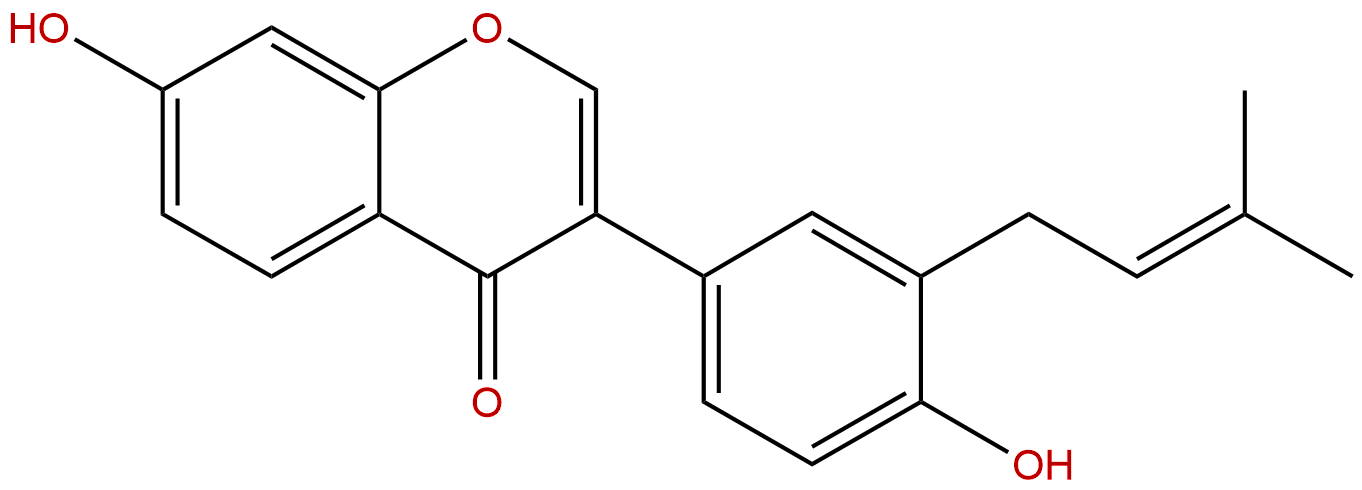
NeobavaisoflavoneCAS No.:41060-15-5
|
||||||||||
 |
|
|
||||||||

| Catalogue No.: | BP0989 |
| Formula: | C20H18O4 |
| Mol Weight: | 322.36 |
Synonym name:
Catalogue No.: BP0989
Cas No.: 41060-15-5
Formula: C20H18O4
Mol Weight: 322.36
Botanical Source: Erythrina sigmoidea and Psoralea corylifolia
Purity: 95%~99%
Analysis Method: HPLC-DAD or/and HPLC-ELSD
Identification Method: Mass, NMR
Packing: Brown vial or HDPE plastic bottle
Can be supplied from milligrams to grams.
For Reference Standard and R&D, Not for Human Use Directly.
Inquire for bulk scale.
Description:
Neobavaisoflavone, exhibits inhibitory activity against DNA polymerase and platelet aggregation, it also has striking anti-inflammatory and anti-cancer effects, Neobavaisoflavone can significantly inhibit the production of reactive oxygen species (ROS), reactive nitrogen species (RNS) and cytokines: IL-1β, IL-6, IL-12p40, IL-12p70, TNF-α in LPS+IFN-γ- or PMA- stimulated RAW264.7 macrophages.
References:
Phytomedicine. 2014 Apr 15;21(5):682-8.
Activity of three cytotoxic isoflavonoids from Erythrina excelsa and Erythrina senegalensis (neobavaisoflavone, sigmoidin H and isoneorautenol) toward multi-factorial drug resistant cancer cells.
Resistance of cancer cells to chemotherapy has become a worldwide concern. Naturally occuring isoflavonoids possess a variety of biological activities including anti-cancer effects. The present study was aimed at investigating the cytotoxicity and the modes of action of three naturally occuring isoflavonoids, Neobavaisoflavone (1), sigmoidin H (2) and a pterocarpan that is a special type of isoflavonoid, isoneorautenol (3) against a panel of nine cancer cell lines, including various sensitive and drug-resistant phenotypes.
METHODS AND RESULTS:
The cytotoxicity of the compounds was determined using a resazurin reduction assay, whereas the caspase-Glo assay was used to detect the activation of caspases 3/7, caspase 8 and caspase 9 in cells treated with compounds 3. Flow cytometry was used for cell cycle analysis and detection of apoptotic cells, analysis of mitochondrial membrane potential (MMP) as well as measurement of reactive oxygen species (ROS). Compounds 3 showed significant cytotoxicity toward sensitive and drug-resistant cancer cell lines. Compounds 1 and 2 were selectively active, and IC50 values below 115 μM were obtained on 6/9 and 4/9 cell lines respectively with values ranging from 42.93 μM (toward CCRF-CEM cells) to 114.64 μM [against HCT116 (p53(+/+)) cells] for 1 and 25.59 μM (toward U87MG) to 110.51 μM [against HCT116 (p53(+/+)) cells] for 2. IC50 values ranging from 2.67 μM (against MDA-MB 237BCRP cells) to 21.84 (toward U87MG) were measured for compound 3 and between 0.20 μM (toward CCRF-CEM cells) and 195.12 μM (toward CEM/ADR5000 cells) for doxorubicin as control drug. BCRP-transfected MDA-MB-231 cells, HCT116 (p53(+/+)) and U87MG.ΔEGFR cells were hypersensitive (collateral sensitive) to compound 3 as compared to their counterpart cell lines. Compound 3 induced apoptosis in CCRF-CEM cells via activation of caspases 3/7, 8 and 9 as well as the loss of MMP and increased ROS production.
CONCLUSIONS:
The cytotoxicity of the studied isoflavonoids and especially the pterocarpan 3 deserve more detailed exploration in the future to develop novel anticancer drugs against sensitive and otherwise drug-resistant phenotypes.
Life Sci. 2014 Jan 30;95(2):101-7.
Neobavaisoflavone sensitizes apoptosis via the inhibition of metastasis in TRAIL-resistant human glioma U373MG cells.
Neobavaisoflavone (NBIF), an isoflavone isolated from Psoralea corylifolia (Leguminosae), has striking anti-inflammatory and anti-cancer effects. Neobavaisoflavone inhibits the proliferation of prostate cancer in vitro and in vivo.
METHODS AND RESULTS:
In this study, we found that Neobavaisoflavone sensitizes human U373MG glioma cells to TRAIL-mediated apoptosis. Co-treatment of TRAIL and Neobavaisoflavone effectively induced Bid cleavage and activated caspases 3, 8, and 9. Importantly, DR5 expression was upregulated by Neobavaisoflavone. We also observed that the combination Neobavaisoflavone and TRAIL increased expression of BAX. We further demonstrate that Neobavaisoflavone induced TRAIL-mediated apoptosis in human glioma cells by suppressing migration and invasion, and by inhibiting anoikis resistance.
CONCLUSIONS:
Taken together, our results suggest that Neobavaisoflavone reduces the resistance of cancer cells to TRAIL and that the combination of Neobavaisoflavone and TRAIL may be a new therapeutic strategy for treating TRAIL-resistant glioma cells.
Molecules. 2011 May 3;16(5):3701-12.
Inhibition of inflammatory mediators by neobavaisoflavone in activated RAW264.7 macrophages.
Flavonoids and coumarins are the major bioactive constituents identified in Psoralea corylifolia. The active fraction isolated from fruits, seeds and roots possesses antibacterial, antioxidative and immunomodulatory properties. Neobavaisoflavone is one of the flavonoids found in Psoralea corylifolia. In the present study we investigated in vitro the anti-inflammatory activity of Neobavaisoflavone.
METHODS AND RESULTS:
Macrophages play an important role in inflammation through the release of inflammatory mediators involved in the immune response. Inappropriate and prolonged macrophage activation is largely responsible for the pathology of acute and chronic inflammatory conditions. Neobavaisoflavone significantly inhibited the production of reactive oxygen species (ROS), reactive nitrogen species (RNS) and cytokines: IL-1β, IL-6, IL-12p40, IL-12p70, TNF-α in LPS+IFN-γ- or PMA- stimulated RAW264.7 macrophages.